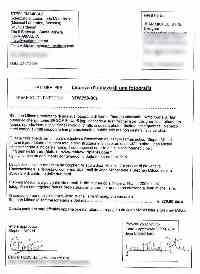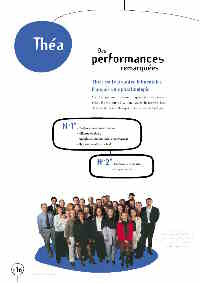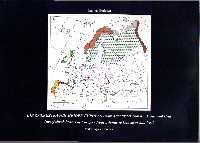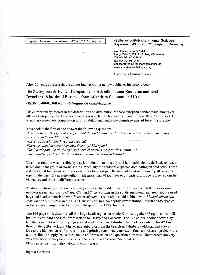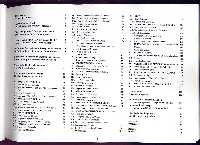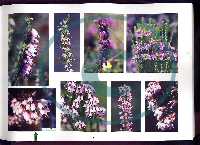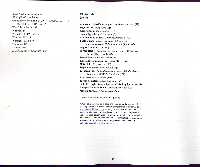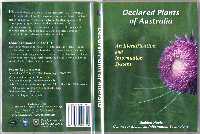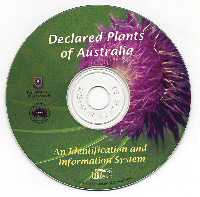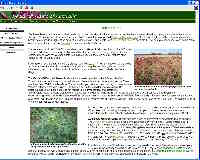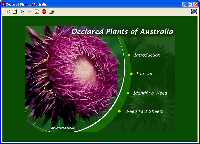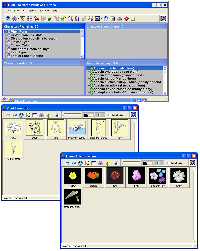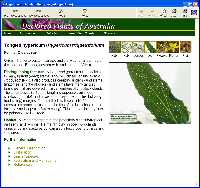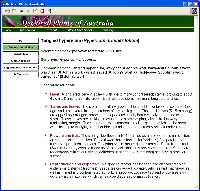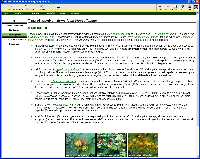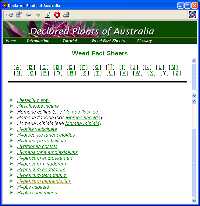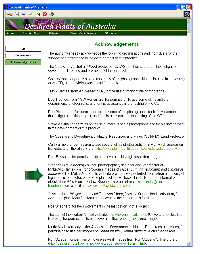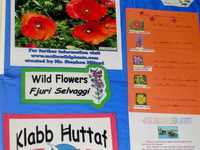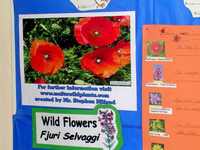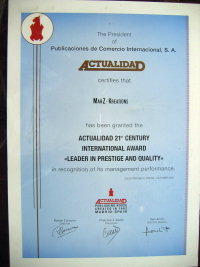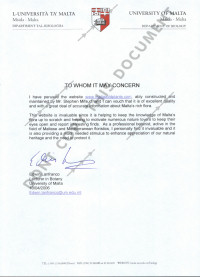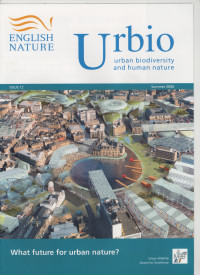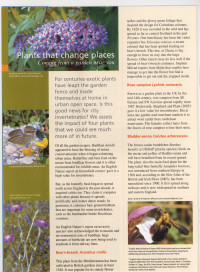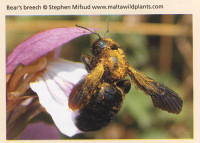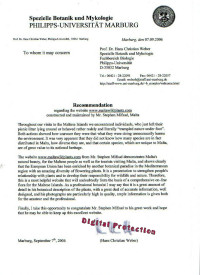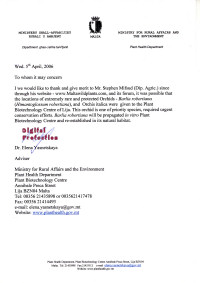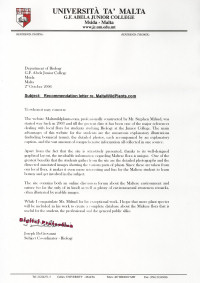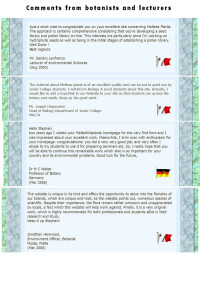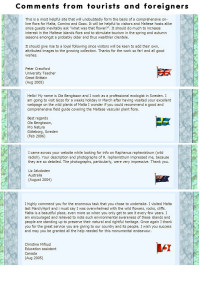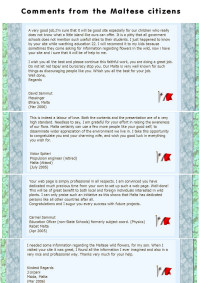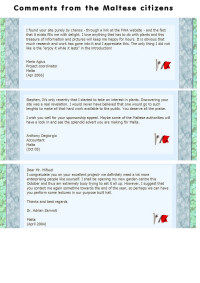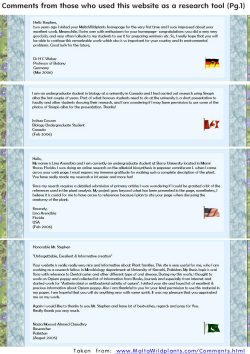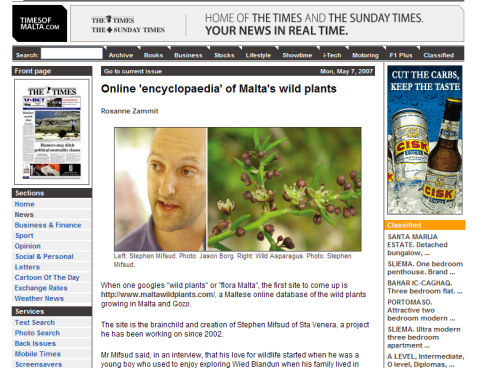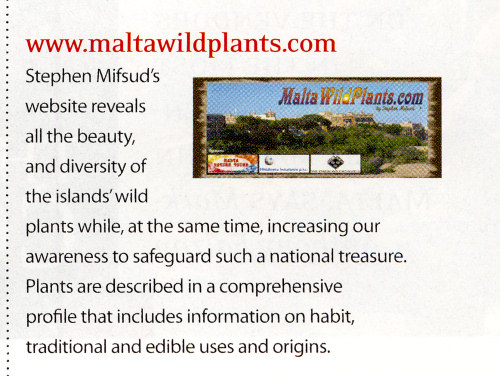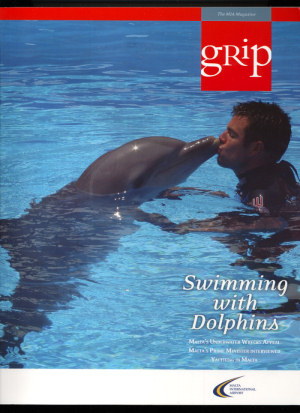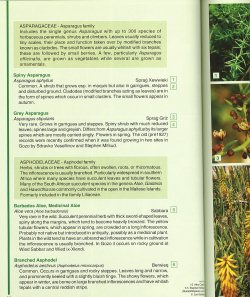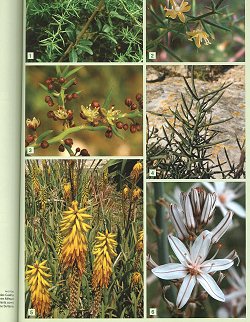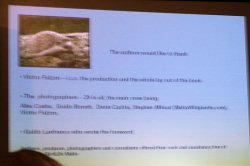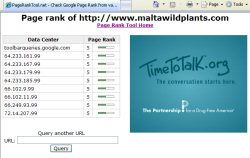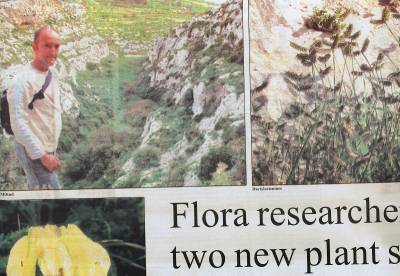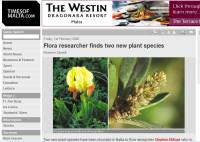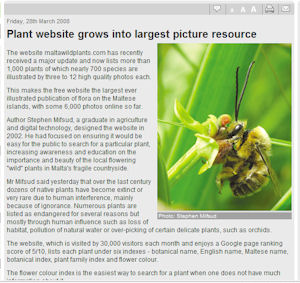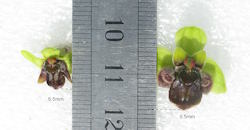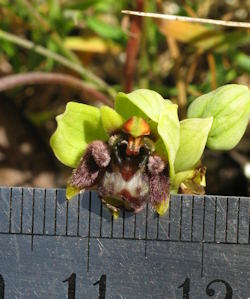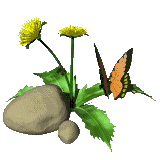 PROMOTION and RECOMMENDATIONS
PROMOTION and RECOMMENDATIONS  |
||||||||||||||||||||||||||||||||||||||||||||||||||||||||||||||||||||||||||||||||||||||||||||||||||||||||||||||||||
This page contains detailed information about those projects and productions that MaltaWildPlants.com has offered contribution to. In other words some of the work on this site have been promoted to such authors, researchers and developers for their projects namely publications, graphic design, PC software, articles, presentations etc. The most and important of these are named in the list below which further detail and sample images about them is give if clicked upon or further down the page.01: Product Promotion artwork for Thea Labs - by J.M.Istre 02: Dwarf shrub heaths of Europe - Book by Ingmar Gorissen 03: Declared Plants of Australia - Interactive CD by Sheldon Navie 04: EkoSkola project for the children of the St.Joseph School, Paola 05: Actualidad International award granted to this website for year 2005 06: Recommendation by Edwin Lanfranco. 07: Urbio Magazine by Ruth Haytrust (Publ. English Nature) 08: Recommendation letter by Prof. Christian Hans Weber. 09: Recommendation letter by Mr. Joseph Degiovanni. 10: Recommendation letter by Dr. Elena Yasnetskaya. 11: Some comments from visitors. 12: MWP featured on The Times of Malta 13: MWP on the Grip magazine (MIA) 14: MWP on "Nature in Gozo" a book about the flora anf fauna of Gozo. 15: MWP have a prestigious Page Ranking of 5 (from a scale of 0-10). 16: Two new records of plant species in Malta (Published on the Times of Malta). 16b: HSBC Cares for the Environment Fund supporty this website in 2008. 17: First set of Fungi Stamps from Malta provided by MaltaWildPlants.com 18: Peer reviewed Scientific Papers by Stephen Mifsud (author of this website) 19: First record of wild Myrtle (Myrtus communis) from Gozo 20: A new Orchid discovered for the first time in Malta 21: Recommendation letter by Dr. Anthony Hamilton 22: Web statistics of visitors' traffic. In July 2004, I was contacted by a French graphics art designer - Jean Michel Istre for using one of my photos in the photogallery of Borage officinalis (Common borage) for promotional graphic design of leaflets and presentation documents for a French laboratory called Thea Laboratories. They were exposing a medicine which amongst others, it uses extracts from Borago officinalis herb. A contract was defined between Mr. Istre and myself for copyright issuing and conditions. The contract and design can be seen by clicking the thumbnails in the table below. This is a clear indication that the photos on the site are of high quality level to be used in promotional artwork.
Colourful book by Ingmar Gorissen About Spring 2004, I was contacted by author and botanist Ingmar Gorissen to use a photo from the photogallery of Erica multiflora and publish it in a book called "Dwarf shrub heaths of Europe - from Atlantic to Caucasus and Ural". The book is bilingual (English/German), and contains 180 pages of A4 pages full of colourful illustrations and detailed information. The quality of the book is superb and nicely presented and laid out. I am very pleased that one of the photos in this excellent book is mine. Look at sample pages of the book in the table below. In August 2004, I was contacted by an Australian author from the Centre for Biological Information Technology (CBIT) named Sheldon Navie who asked me for permission to use some photos of Diplotxis erucoides and Hypericum triquetrifolium from maltawildplants.com. I granted permission, given that relevant credits are given for my photographs.
In mid November 2005, Jacqueline Vanhear, a teacher at St.Joseph School Paola, and also co-ordinator of the EkoSkola programme and Birdlife activities made contact with me in order to gain permission to use photos and material from my website for an Educational and Environmental Project known as the EkoSkola. Permission was granted given the website is mentioned somewhere.
My hard work, determination and effort that I put in creating and updating the site have resulted in winning an INTERNATIONAL AWARD granted by Actualidad 21st century, an award giving company leader in publishing, websites and other promotions.
This is a recommendation letter by Edwin Lanfranco, lecturer at the University of Malta and experienced local botanist about the MaltaWildplants.com project.
In May 2006, Editor Ruth Haytrust have written to me an email to ask permission to use one of my photos in the journal called Urbio (Urban biodiversity and human nature) published by English Nature. The photo was used for an article about 'plants that changes places' as seen in the pic below. The article was published in Summer 2006 as Issue 12. If you want to subscribe and order this and other issues of this journal, you can have a look at the publishing company site - www.nature-english.org.uk. Greetings to Ruth from Malta.
This is a recommendation letter by Prof. Chris Hans Weber, Professor of Botany at the University of Marburg, about the MaltaWildplants.com project.
This is a recommendation letter written by Dr. Elena Yasnetskaya, adviser at the National Plant Biotechnology Centre about the MaltaWildplants.com project.
This is a recommendation letter by Mr. Joseph Degiovanni, Head of the Biology Department of the Junior College (part of the University of Malta), about the MaltaWildplants.com project. These comments where taken from the Visitors Comments Page (click here) where visitors can submit their comments via the online form. All comments received are logged by the User IP.
Some of the most important comments received about the project from various visitors both locally and around the world. Click on thumbnails to view a large preview and read the corresponding comments.
Several thousands of readers of the Times of Malta, (the most selling newspaper on the islands) could read a full colour-page article about the research project about Maltese Flora. The sponsors where mentioned black on white in the article. The article was written by Rosanne Zammit. Another article about the website was previously published on the Sunday Times of Malta on the last Sunday of November.
The Grip is a colour and high quality magazines produced by WaterMelon Productions for Malta International Airport which it hands out for free to tourists visiting the airport. Some 40,000 copies are handed out. A small advert/article was published on the July/August issue and again the sponsors were shown.
The book called "Nature in Gozo" by John J. Borg, Edwin Lanfranco and Joe Sultana which launched on the 9th of October 2007 is composed of 3 categories:
The Page Rank is a numeric value that represents how important a page is on the web. It is a range from 0-10 where the higher it gets the better the website is on the internet. I am very pleased to inform you that MaltaWildplants.com have a page rank 5. From 1.6 million websites in the world, only 21,000 c. are currently ranked as PR5. To understand better how prestigious this Page Ranking is, we can compare this value of other popular multi-funded websites in Malta:
The author of this website, Stephen Mifsud, have found 2 new species of plants that was not recorded during the last 180 years or so that the flora of the Maltese islands was studied scientifically. The plants consists of the Grass - Dactyloctenium aegyptium and the Amaranth - Amaranthus muricatus. The former is only found in few stations in Europe, only in Italy (incl. Sicily), Crete and possibly Spain. This research which involves a large amount of time, is co-sponsored by MiddleSea (2007), Strickland Foundation and HSBC (2008). Click the link below to read the full article.
Click the image below to read the article published on the Times of Malta. (28 Mar 2008)
For the first time in history, Maltapost have issued a set of stamps related to fungi (mushrooms) from the Maltese islands, thanks to the participation of Maltawildplants.com which offered the photos and some basic research about the 5 species of fungi that have been selected for this issue. The species are:
|
||||||||||||||||||||||||||||||||||||||||||||||||||||||||||||||||||||||||||||||||||||||||||||||||||||||||||||||||||
 |
| Preview of the Stamp collection with the theme "Maltese Fungi" |
In the last couple of years, the author of this website (Stephen Mifsud) wrote a number of scientific papers related to botanical discoveries in the Maltese islands. The list of Papers till 2009 is given below:
-
Mifsud Stephen (2007). "UPDATES IN THE FLORA OF THE MALTESE ISLANDS (CENTRAL MEDITERRANEAN)", The Central Mediterranean Naturalist 4(3): 171-179 Malta, November 2007.
Abstract: Discovery of new populations in Malta of the very rare Ornithogalum divergens, Asparagus stipularis, Muscari commutatum, Muscari neglectum, Vicia bithynica, Cardaria draba and Abutilion theophrasti, rediscovery of Trifolium pratense (last report of this species 80 years ago) and a new species from Malta - Calendula bicolor
-
Mifsud Stephen (2008). "THREE NEW SPECIES FROM THE GENUS OPHRYS, SECTION PSEUDOPHRYS [FAM: ORCHIDACEAE] ON THE MALTESE ISLANDS", The Central Mediterranean Naturalist 4(4): 243-252 Malta, November 2008
Abstract: This article deals with the first substantiated records from the Maltese islands of Ophrys lupercalis J. Devillers-Terschuren & P.
Devillers and Ophrys lojaconoi P. Delforge, both forming part of the Ophrys fusca group, and of Ophrys phryganae J. Devillers-
Terschuren & P. Devillers, belonging to the Ophrys lutea group. Identification is based on isometric morphological analysis,
following the Delforge taxonomical system. Treatment of these taxa according to another taxonomical system by Baumann,
Kunkele and Lorenz is also discussed.
-
Mifsud Stephen (2008). "AN ASSESSMENT ON THE DISTRIBUTION OF IRIS PSEUDOPUMILA TINEO [FAM. IRIDACEAE] IN THE MALTESE ISLANDS AND COMPARISON OF ITS TWO FLOWER FORMS", The Central Mediterranean Naturalist 4(4): 253-262 Malta, November 2008
Abstract: The distribution of Iris pseudopumila Tineo in the Maltese islands is given, including information on four new
populations. A comparison study between three populations of the yellow-flower form, and between the violet and
yellow forms are provided, the latter showing marked morphological differences between the two colour forms in the
Maltese islands.
-
Mifsud Stephen (2008). "FOUR NEW RECORDS FOR THE FLORA OF THE MALTESE ISLANDS - DACTYLOCTENIUM AEGYPTIUM (L.) P.BEAUV. (FAM. POACEAE), AMARANTHUS MURICATUS (GILLIES EX MOQ.) HIERON. (FAM. AMARANTHACEAE), FUMARIA REUTERI BOISS.(FAM. FUMARIACEAE) AND SPIRODELA OLIGORRHIZA(KURTZ) HEGELM. (FAM. LEMNACEAE)", The Central Mediterranean Naturalist 4(4): 263-273 Malta, November 2008
Abstract: Four plant species are reported as new to the flora of the Maltese islands: Dactyloctenium aegyptium (L.) P.Beauv. (Family Poaceae), Amaranthus muricatus (Gillies ex Moq.) Hieron. (Family Amaranthaceae), Fumaria reuteri Boiss. (Family Fumariaceae) and Spirodela oligorrhiza (Kurtz) Hegelm. (Family Lemnaceae). The article gives worldwide distribution, plant characteristics and information on the location and habitat that they were found in. The article is complemented by several illustrations.
-
Mifsud Stephen (2009). "ZANNICHELLIA MAJOR BOENN. EX RCHB. � A FIRST RECORD OF A NON-ENDEMIC SPECIES OF ZANNICHELLIA L. (FAM. ZANNICHELLIACEAE DUM.) FROM THE MALTESE ISLANDS", The Central Mediterranean Naturalist 5(1): 1-6 Malta, Dec 2009
Abstract: The first record of Zannichellia major Boenn. ex Rchb. is reported from the Maltese islands. Detailed morphological comparison of this population with the endemic and frequent Zannichellia melitensis Brullo, Giusso & Lanfranco and other monoecious Zannichellia species is given. Distribution of this species is discussed.
-
Mifsud Stephen (2009). "UPDATE OF THE MALTESE FLORA (CENTRAL MEDITERRANEAN) INCLUDING VERY RARE SPECIES OR SPECIES THOUGHT TO BE EXTINCT FROM MAINLAND MALTA OR ITS ISLANDS", The Central Mediterranean Naturalist 5(1): 7-16 Malta, Dec 2009
Abstract: Rediscovery of Lotus halophilus from mainland Malta (presumed to be found only in the island of Comino), Xanthium strumarium (presumed extinct), first record of Myrtus commuis from the island of Gozo and the very rare plant Asplenium trcihomanes are reported from the Maltese Islands. An account about the each population and an updated distribution of the species in Malta is given.
-
Mifsud Stephen (2009). "REDISCOVERY AND PRESENT DISTRIBUTION OF VALANTIA HISPIDA L. (FAM. RUBIACEAE) IN THE MALTESE ISLANDS", The Central Mediterranean Naturalist 5(1): 17-23 Malta, Dec 2009
Abstract: Valantia hispida L. is an indigenous species presumed extinct from the Maltese islands due to lack of any substantiated records for more than 130 years. The rediscovery of this species is reported. An account of the population found in the South East area of the island of Gozo is given. Morphological differences between V. hispida L. and the frequent V. muralis L. are illustrated. The taxon V. muralis var. hirsuta reported from Malta in old literature is discussed.
-
Mifsud Stephen (2009). "A NEW FORM OF OPHRYS BOMBYLIFLORA LINK DESCRIBED FROM MALTA", Journal of European Orchids 41(3/4): 611-622 Germany, Dec 2009
Abstract: A new form, Ophrys bombyliflora Link forma parviflora S. Mifsud is described for plants with significantly smaller lips from the typical form of O. bombyliflora and with a bright, contrasting speculum. These plants were observed as homogenous populations in 2 different sites in Malta, isolated from populations of the locally common Ophrys bombyliflora Link.
Abstract: Discovery of new populations in Malta of the very rare Ornithogalum divergens, Asparagus stipularis, Muscari commutatum, Muscari neglectum, Vicia bithynica, Cardaria draba and Abutilion theophrasti, rediscovery of Trifolium pratense (last report of this species 80 years ago) and a new species from Malta - Calendula bicolor
Abstract: This article deals with the first substantiated records from the Maltese islands of Ophrys lupercalis J. Devillers-Terschuren & P. Devillers and Ophrys lojaconoi P. Delforge, both forming part of the Ophrys fusca group, and of Ophrys phryganae J. Devillers- Terschuren & P. Devillers, belonging to the Ophrys lutea group. Identification is based on isometric morphological analysis, following the Delforge taxonomical system. Treatment of these taxa according to another taxonomical system by Baumann, Kunkele and Lorenz is also discussed.
Abstract: The distribution of Iris pseudopumila Tineo in the Maltese islands is given, including information on four new populations. A comparison study between three populations of the yellow-flower form, and between the violet and yellow forms are provided, the latter showing marked morphological differences between the two colour forms in the Maltese islands.
Abstract: Four plant species are reported as new to the flora of the Maltese islands: Dactyloctenium aegyptium (L.) P.Beauv. (Family Poaceae), Amaranthus muricatus (Gillies ex Moq.) Hieron. (Family Amaranthaceae), Fumaria reuteri Boiss. (Family Fumariaceae) and Spirodela oligorrhiza (Kurtz) Hegelm. (Family Lemnaceae). The article gives worldwide distribution, plant characteristics and information on the location and habitat that they were found in. The article is complemented by several illustrations.
Abstract: The first record of Zannichellia major Boenn. ex Rchb. is reported from the Maltese islands. Detailed morphological comparison of this population with the endemic and frequent Zannichellia melitensis Brullo, Giusso & Lanfranco and other monoecious Zannichellia species is given. Distribution of this species is discussed.
Abstract: Rediscovery of Lotus halophilus from mainland Malta (presumed to be found only in the island of Comino), Xanthium strumarium (presumed extinct), first record of Myrtus commuis from the island of Gozo and the very rare plant Asplenium trcihomanes are reported from the Maltese Islands. An account about the each population and an updated distribution of the species in Malta is given.
Abstract: Valantia hispida L. is an indigenous species presumed extinct from the Maltese islands due to lack of any substantiated records for more than 130 years. The rediscovery of this species is reported. An account of the population found in the South East area of the island of Gozo is given. Morphological differences between V. hispida L. and the frequent V. muralis L. are illustrated. The taxon V. muralis var. hirsuta reported from Malta in old literature is discussed.
Abstract: A new form, Ophrys bombyliflora Link forma parviflora S. Mifsud is described for plants with significantly smaller lips from the typical form of O. bombyliflora and with a bright, contrasting speculum. These plants were observed as homogenous populations in 2 different sites in Malta, isolated from populations of the locally common Ophrys bombyliflora Link.
 |
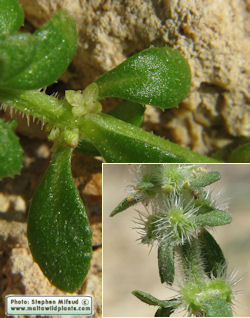 |
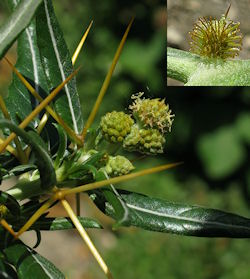 |
| Muscari commutatum | Valantia hispida | Xanthium spinosum |
The rare Myrtus communis, the Myrtle tree (Rihan in English), has been reported only from Mainland Malta and present in few scattered populations. Several populations consists of a clump of few trees or even a singular specimen. The first population was reported by Grech Delicata in 1853, located at Wardija and corresponds to the largest population in the Maltese islands, followed by a population of numerous specimens at Gnien Ingraw and Girgenti. The toponyms of Ghajn Rihana (at Burmarrad) and Wied ir-Rihan (at Qala, Gozo) give an indication that this species used to exist in larger numbers in the past. The latter toponym do also suggest that the Myrtle used to be present in Gozo, but however, no record of this species exists from ths sister island of Malta. It was only in 2009, that Stephen Mifsud had found a single specimen literally entangled with Bramble, Smilax, wild Asparagus and other wild plants. Mr. Mifsud, regularly goes to check the Gozitan specimen and removes unwanted vegetation around, despite the perilous journey to reach the site.
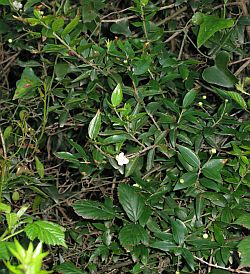 |
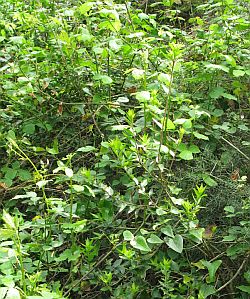 |
| Myrtus communis from Gozo | Myrtus communis from Gozo |
The most remarkable discovery by the author of this website was so far the discovery of a new Orchid from Malta - a form or variety with smaller flowers of the common Bumblebee Orchid - Ophrys bombyliflora. In most other plant families and Genera, the variation of size in flowers have little if any significance importance, but not for the Orchid Genus of Ophrys, where the shape, scent, and size of the flower have to match the requisites of specific pollinator(s) to carry out pollination.
This form resembles Ophrys bombyliflora, but it is about two thirds smaller. It has other minor differences such as a more oblong median lobe instead that of a globular one and often has a more contrasting ash-grey patterns on its dark brown modified petal � the labellum or lip.
The discovery took place on the 1st March 2007, but the author only realized that this was something very important when visiting the plant in the consecutive year where he found that all the 100-120 plants residing a 3m2 area had such small flowers and large leaves, and hence it was neither a casual occurrence, nor a case of stunted growth. Study pursued for 2 other years were a simaller but smaller population was also found in limits of Rabat.
This discovery was discussed with the German Orchidologist - Dr. Richard Lorenz, who agreed that this plant should be described as a new taxon. Since in general, the small-flowered plants looks similar to the common Ophrys bombyliflora, and due the fact that genetic analysis and pollination studies could not be carried out by the author's budget, the taxon was limited to a form. If the pollinator is found to be different from that of the normal Ophrys bombyliflora (eg: Eucera oraniensis - Pic: OPHBO-39 ), that might bring this plant to have a higher taxonomical ranking namely a sub-species.
This small-flowered Bumblebee Orchid was described by the author in the Journal of European Orchids, a continental journal were scientists like E. Lanfranco, D. Stevens, E. Pulvirenti, and G. Bartolo have written article(s) about European Orchids. The reference of this paper is Mifsud Stephen (2009). A new form of Ophrys bombyliflora LINK described from Malta, Journal of European Orchids 41(3/4): 611-622 Malta, Dec 2009.
This is a recommendation letter by Dr. Anthony Paul Hamilton, retired Senior Lecturer of Botany at the University of London, University of Durham and University of East London. Click thumb below to view this endorsment with regards my work.
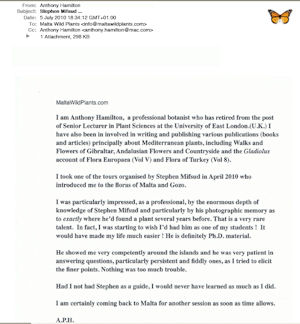 |
||
| txt 1 | txt 2 | txt 3 |
Below you find a table of what are known as "Web statistics" which basically show values representing how many times the website has been visited and the size of data that has been downloaded. These values are generated by the server of the host company. The most important value is the number visits per month and unique visitors, with values of 33,808 and 23,232 respectively for the month of March. Older statistics: Web statistics 1 / Web statistics 2 / Web statistics 3 / Web statistics 4
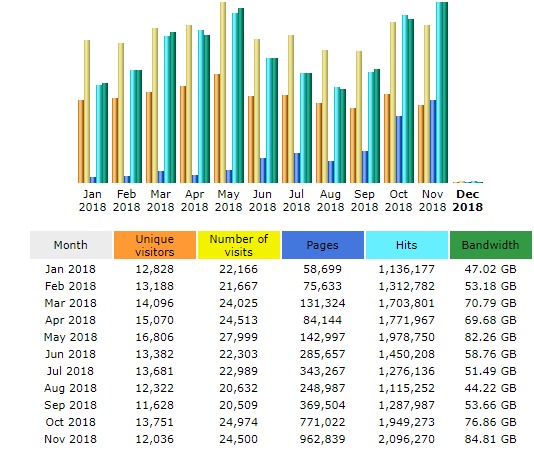 |
| Web statistics of the website. |

